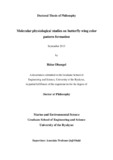Please use this identifier to cite or link to this item:
http://archive.nnl.gov.np:8080/handle/123456789/253| Title: | Molecular physiological studies on butterfly wing color pattern formation |
| Authors: | Dhungel, Bidur |
| Keywords: | Wings - butterfly Baculovirus anti-gp64 antibody Junonia orithya pupae Nymphalid butterflies |
| Issue Date: | 5-Dec-2017 |
| Abstract: | Butterfly wings provide excellent materials for pattern formation and diversification study. Butterfly wings are composed of pattern elements that are idealized in the “nymphalid ground plan”, and study of these element formation and diversification aids in the actual study of pattern formation and diversification. Among the elements on butterfly wings, concentric rings of colored scales, eyespots, are widely studied elements. Immunohistochemistry and in situ hybridization studies showed a number of genes expressed in and around the presumptive focus during eyespot development. In the absence of reliable and reproducible functional assay system, the functional evidence of the candidate genes has been lacking. Several methods to transfer and express a foreign gene in butterfly wings have been reported, but they were suffering from low success rates or lower expression levels. I here developed a functional assay system using the blue pansy butterfly Junonia orithya. I obtained the successful expression of foreign gene GFP (Green fluorescence protein) in J. orithya with baculovirus injection followed by anti-gp64 antibody injection. The expression pattern of candidate gene Distal-less (Dll) at the center of the eyespot and later again at scale building cells around foci of the eyespot implicates its role in eyespot formation. However, the ectopic expression of Dll using baculovirus gene delivery tool did not produce any ectopic eyespot. I conclude that the expression of Dll is not sufficient for eyespot formation. Nevertheless, the baculovirus tool can be an invaluable tool to transfer, express, and functionally examine foreign genes in butterfly wings. On the other hand, the DNA polymorphism in one of the candidate gene Dll is linked with eyespot size variation in Bicyclus anynana. Using J. orithya, I compared Dll cDNA sequence variations on one side of the wing with color pattern on the other side from the identical individual, as the butterfly has the identical wing color pattern on both sides. I found three different types of Dll variants in J. orithya wing however no clear relationship between Dll sequence and eyespot variation was observed. In the future, with the in situ hybridization technique, the precise location of the individual Dll variants can be traced and the molecular basis of morphological variation can be established. To establish a standard rearing method, we reported various artificial diets for J. orithya. The modified Insecta F-II diet was used for rearing J. orithya larvae. Interestingly I found, three diets AD-FZMUV, AD-FZM and AD-FBY produced homeotic transformed adults and diet AD-FBY kept larvae at longer time at an earlier stage. The modified artificial diet Insecta F-II was used to feed pharmacological agent sodium tungstate to compare with low temperature treatment, whether it can induce hardiness against tungstate and cold-shock treatment in terms of TS-type modification and fall-morph. The low temperature experience, but not consumption of tungstate during the larval stage, induced hardiness against coldshock or tungstate treatment. Low temperature treatment at larval stage provided immunity against cold shock or tungstate treatment. Therefore, I speculate that the cold-shock or tungstate induced color-pattern pathway has a physiological relationship with the fall-morphinducing pathway. The use of artificial diets can increase the use of a particular organism for experimental use. In addition, using three nymphalid butterflies, J. orithya, Vanessa cardui, and Danaus chrysippus, the mechanism of tissue size determination during morphogenesis was studied by counting and measuring all the scales on one of the compartment of the wing. I found that, the butterfly wing tissue size is determined primarily by the number of scale cells and then by the size change of scale cells before or during the period of row arrangement. The putative morphogen signal is likely a ploidy signal that determined cell size and scale size. It also likely determines scale coloration and shape. In summary, based on the current knowledge, I proposed an integrated model for the wing color pattern formation and modification. |
| Description: | A dissertation submitted to the Graduate School of Engineering and Science, University of the Ryukyus, in partial fulfillment of the requirements for the degree of Doctor of Philosophy Marine and Environmental Science Graduate School of Engineering and Science University of the Ryukyus, 2013. |
| URI: | http://103.69.125.248:8080/xmlui/handle/123456789/253 |
| Appears in Collections: | 500 Natural sciences and mathematics |
Files in This Item:
| File | Description | Size | Format | |
|---|---|---|---|---|
| Phd Thesis Bidur Dhungel.pdf | 6.19 MB | Adobe PDF |  View/Open |
Items in DSpace are protected by copyright, with all rights reserved, unless otherwise indicated.